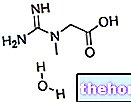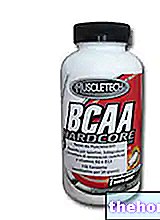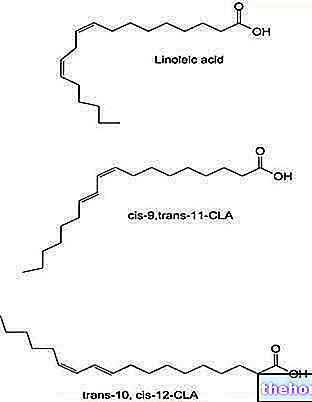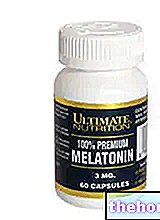
Information on Acetyl carnitine plus - Ultimate Italia
Food supplement of acetyl L carnitine.
FORMAT
90 cps bottle
COMPOSITION
Acetyl L-Carnitine HCL: stable form of the active ingredient
Calcium pantothenate (Vitamin B5)
Vitamin B6
Vitamin B2
Capsule: food gelatin
Excipient: Magnesium stearate.
One capsule contains:
Acetyl L-Carnitine 200 mg - L "ALC (Acetyl L-Carnitine) represents the trimethyl ester of the more common L-Carnitine; it is produced at the mitochondrial level by kidney, liver and brain cells, starting from L-Carnitine and an acetyl group. The presence of an acetyl residue makes the active ingredient more easily absorbable, so much so that studies show how the supplementation of 2gr / day can produce an increase in blood levels of 43%. The ALC is able to guarantee, by crossing the mitochondrial membrane, the regeneration of L-carnitine and the transfer of a group acetyl for oxidative purposes, with consequent enhancement of lipid metabolism. In fact, L-carnitine and its acyl ester function as transporters of fatty acids in the mitochondrial matrix, promoting the B-oxidation process. Furthermore, the mimetic colino action also allows an important activation of the neuronal mitochondrial metabolism, preserving it from degeneration.
Calcium pantothenate 5 mg - also known as Vitamin B5, it is part of the synthesis of Coenzyme A (ATP + VitB5 + Cys), which plays a key role in all the reactions in which the transfer of an acyl group takes place (oxidative decarboxylation of pyruvate, of the "α- ketoglutarate, oxidation of fatty acids). It therefore plays a central role in both glucose and lipid metabolism. The recommended daily dose ranges from 4 mg to 7 mg; however, given the presence of this vitamin in many foods (mainly whole grains) , deficiencies are found only in severe cases of malnutrition.
Pyridoxine (Vitamin B6) 1 mg - pyridine derivative introduced mainly through meat; it is absorbed in the fasting state, after ATP-dependent hydrolysis and reaches the liver bound to albumin. Here it is transformed into pyridosamine and then into pyridoxal and subsequently phosphorylated, with consequent activation and storage. From the liver it will then be released into the circulation not phosphorylated, for reach various tissues where, once rephosphorylated, it can carry out its biological role.Vitamin B6 participates as a coenzyme in numerous reactions mainly involved in amino acid metabolism (transamination and oxidative deamination), lipid (synthesis of sphingolipids) and glucose.
Its daily requirement is around 1 / 1.5 mg, but even in this case the cases of deficiency are very rare.
Riboflavin (Vitamin B2) 0.85 mg- introduced mainly through eggs, milk and vegetable derivatives, it is absorbed in the intestine, after having been dephosphorylated. By binding to albumin, but also to Ig, it reaches the liver, where it is transformed into the coenzyme forms FMN and FAD.
These two prosthetic groups, essential for metabolism in general, are included in the oxidative decarboxylation process of pyruvate, in the krebs cycle, in the B-oxidation of fatty acids, in the oxidation of amino acids and in oxidative phosphorylation.
The recommended daily dose is 0.6 mg for every 1000 kcal introduced with the diet.
Product features Acetyl carnitine plus - Ultimate Italia
This supplement, in addition to providing acetyl L carnitine in the dosage of 200mg per capsule, also guarantees the supply of three essential vitamins in oxidative processes. The intent would be to provide some of the elements necessary to support oxidative metabolism, and in particular that lipid, thus optimizing the use of fatty acids for energy purposes.
Method of use recommended by the company - Acetyl carnitine plus - Ultimate Italia
1 capsule a day in a little water.
Directions for use in sports Acetyl carnitine plus - Ultimate Italia
In sports, the dosages usually recommended vary from 500 mg to 2 / 2.5 g, taken in divided doses during the day, and increasing or decreasing weekly. Studies on the pharmacokinetics of carnitine show that food has a bioavailability of over 75% (54-87%), probably due to the modest doses present in food and above all to intestinal transport (cotransport with sodium) of ALC mediated by the OCTN2 transporter. On the other hand, the bioavailability of carnitine present in supplements is at minimum values (14-18% for L-carnitine). This could suggest the possibility of taking this supplement with meals, even if the limiting factor is not so much intestinal absorption as its storage in the muscles, not yet fully characterized.
Rationale for use - Acetyl carnitine plus - Ultimate Italia
Recent studies show the ability of ALC to preserve and support aerobic muscle capacity (study carried out on rats); this could be a start for a more detailed evaluation of its effects in sports or in facilitating the weight loss process.Although acetyl L carnitine has been shown to be effective in improving aerobic muscle performance in rats undergoing exercise, in reducing fatigue in patients with multiple sclerosis and in reducing glucose oxidative markers after intense physical exertion, there is a lack of studies in the literature demonstrating the ergogenic properties of this supplement on healthy individuals, as well as lacking studies in association with vitamin elements.
Acetyl carnitine plus side effects - Ultimate Italia
At high doses, episodes of insomnia, nausea, abdominal cramps, migraines and gastrointestinal disorders, although rare, may occur.
Precautions for use Acetyl carnitine plus - Ultimate Italia
Contraindicated in cases of renal, hepatic, diabetic, pregnancy, lactation, mood disorders.
This article, elaborated on the critical rereading of scientific articles, university texts and common practice, is for information purposes only and therefore has no medical prescription value. It is therefore always required to consult your doctor, nutritionist or pharmacist before undertaking the use of any supplement.. Further information on the critical analysis of Acetyl carnitine plus - Ultimate Italia.
Applied metabolics - vinegars l carnitine.
J Physiol. 2007 June 1; 581 (Pt 2): 431-44
New insights concerning the role of carnitine in the regulation of fuel metabolism in skeletal muscleFrancis B Stephens, Dumitru Constantin-Teodosiu, and Paul L Greenhaff
Ann N Y Acad Sci. 2004 Nov; 1033: 30-41.
Kinetics, pharmacokinetics, and regulation of L-carnitine and acetyl-L-carnitine metabolism Rebouche CJ.
Gastroenterology. 1986 Jul; 91: 10-6.
Carnitine transport in human intestinal biopsy specimens. Demonstration of an active transport system. Hamilton JW, Li BU, Shug AL, Olsen WA.
J Appl Physiol. 1988 Jun; 64: 2394-9.
Influence of carnitine supplementation on muscle substrate and carnitine metabolism during exercise. Soop M, Björkman O, Cederblad G, Hagenfeldt L, Wahren J.
Carnitine for fatigue in multiple sclerosis.
Tejani AM, Wasdell M, Spiwak R, Rowell G, Nathwani S. Cochrane Database Syst Rev. 2010 Feb 17; 2: CD007280.
Prog Lipid Res. 2010 Jan; 49: 61-75. Epub 2009 Aug 29.
Acylcarnitines: role in brain. jones LL, McDonald DA, Borum PR.
Muscle unloading potentiates the effects of acetyl-L-carnitine on the slow oxidative muscle phenotype.
Cassano P, Flück M, Giovanna Sciancalepore A, Pesce V, Calvani M, Hoppeler H, Cantatore P, Gadaleta MN.
Biofactors. 2010 Jan; 36: 70-7.
A DIGE approach for the assessment of rat soleus muscle changes during unloading: effect of acetyl-L-carnitine supplementation.
Moriggi M, Cassano P, Vasso M, Capitanio D, Fania C, Musicco C, Pesce V, Gadaleta MN, Gelfi C.
Proteomics. 2008 Sep; 8: 3588-604.
[Clinical and biochemical studies in a case of acute encephalopathy associated with calcium hopanthenate administration]
Kajita M, Iwase K, Matsumoto M, Kuhara T, Sinka T, Matsumoto I. Department of Pediatrics, Kohseiren Kamo Hospital, Aichi.
Mol Genet Metab. 2001 Aug; 73: 287-97.
Carnitine transport by organic cation transporters and systemic carnitine deficiency.
Lahjouji K, Mitchell GA, Qureshi IA. Division of Medical Genetics, Hôpital Sainte-Justine, 3175 Cote Sainte-Catherine, Montreal, Quebec H3T 1C5, Canada.
Yakugaku Zasshi. 2002 Dec; 122: 1037-58.
Biopharmaceutical studies on molecular mechanisms of membrane transport
Article in Japanese




























